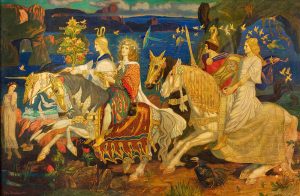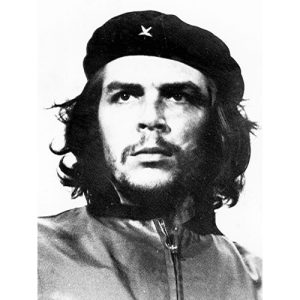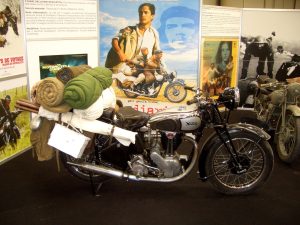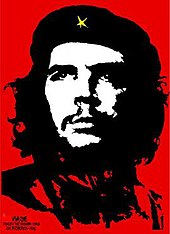The following article was written by Jim Aitken and was first posted by culture matters.
PORTRAIT OF A REVOLUTIONARY: GUEVARA IN KILKEE
Sixty years ago, in 1963, an Aeroflot flight from Moscow was on route to Havana and had to stop at Shannon airport due to fog. Shannon, then as now, is famous for fog. At that time an arrangement had been hatched between Shannon and the County Clare town of Kilkee to take passengers by bus to view the marvellous scenery this part of Clare offers.
Kilkee had long been popular with tourists and bathers, and the author of the imperialist novel King Solomon’s Mines, H. Rider Haggard, had once visited Kilkee as did Charlotte Bronte who spent her honeymoon here. Alfred Tennyson also visited the town. The Irish actor Richard Harris, though born in Limerick, considered Kilkee his spiritual home and spent summers here as a boy. There is a statue to him in the town which was unveiled by Russell Crowe.
Back in 1963 a group of three men dressed in overcoats came in to Kilkee’s Marine Hotel via swing doors to the side entrance. Momentarily, it had that Clint Eastwood feel about it. They had been on the Aeroflot flight and after visiting Limerick they had been bussed here to Kilkee. A young sixteen-year-old student called Jim Fitzpatrick was working here in the bar on leave for the summer from the Franciscan Gormanston College in County Meath he attended.
Che Guevara, I presume?
Fitzpatrick was already a convinced leftist and recognised immediately one of the three men as Che Guevara. The young student had described his college as ‘right wing fundamentalist Catholic’ but he nonetheless admired the missionary work the Franciscans had been doing in South America. This was a period when liberation theology had taken root in this vast continent and Fitzpatrick had also been a keen student of the events surrounding the Cuban revolution, via Pathe News.
Guevara had realised that he had been recognised and asked Fitzpatrick to recommend a drink. While discounting rum, he suggested an Irish whiskey with some water. A Powers whiskey was duly poured and Guevara sipped it slowly. They struck up a conversation in the Argentinian’s faltering English with Guevara telling Fitzpatrick he was proud of his Irish roots. Guevara’s father actually bore the surname Lynch while his great-grandmother was from Galway, and other family members came from Cork.
Che was curious about Ireland ‘from a revolutionary point of view’. He was full of admiration for the fact that Ireland was the first country to ‘shake off the shackles of the British Empire’. He would have been well aware of the large population of Irish descendants, like himself, who lived in Argentina. It is reckoned to be over a million strong and these descendants form the largest Irish community in any non-English speaking country in the world. In fact, Argentina is home to the fifth largest Irish community in the world. The footballer Alexis MacAllister, who plays for Liverpool, is currently the most notable member of this community.
The Irish contribution to South American liberation struggles
Guevara would, of course, have been equally proud of the role played by the Irish during the South American wars of national liberation. The Liberator himself, Simón Bolívar, who not only managed to rid this continent of Spanish rule but had a vision of it being a united whole, had the outstanding support, both as aide-de-camp and as his diarist, of one Daniel Florencio O’Leary who hailed originally from Cork.
In 2010 the Venezuelan Government presented a plaque and bust of O’Leary to the people of Cork. Another bust of Chile’s first head of state who had also fought with Bolívar was Bernardo O’Higgins, and his bust resides in the gardens of Dublin’s Merrion Square. This square was once home to W.B. Yeats, Oscar Wilde, Henry Grattan and Ireland’s own Liberator, Daniel O’Connell. Today the fashion designer Louise Kennedy and Dermot Desmond, the major shareholder in Celtic Football Club, live there.
There were even two Irish battalions who took part in Latin American wars. The 1st Regiment Venezuelan Rifles took part in the Venezuelan War of Independence and the Saint Patrick Battalion was an Irish American battalion that deserted and fought on the Mexican side during the Mexican-American War (1846-48).
The Irish writer Tomás Mac Síomón gave a fulsome expression of the extent of Irish involvement in Latin America in his book From One Bright Island Flown: Irish Rebels, Exiles, and Martyrs in Latin America. (Nuascéalta, 2022). As well as mentioning Guevara he also wrote of the exploits of one Guillén Lampart upon whom the legend of Zorro is based. Another Argentinian, Rodolfo Walsh, gave his assistance to the Cuban revolution by managing to decipher encrypted messages at Prensa Latina, the famous Special Services news agency he founded. Walsh passed on the message to Castro and enabled Cuba to prepare for the CIA invasion at the Bay of Pigs.
Sadly, Rodolfo Walsh was to be murdered at the hands of the Argentine military junta (1976-1983) because of his involvement with left wing trade unionism and for his journalism. The Colombian writer Gabriel García Márquez described Walsh’s Open Letter to the Military Junta as a ‘masterpiece of universal journalism.’
Guevara would have been well aware of the Irish military diaspora’s exploits in Latin America just as he would have been aware of the exploits of previous Irish rebels throughout the long struggle for Irish independence.
The barman Jim Fitzpatrick would go on to become one of Ireland’s most famous artists. In 1978 he wrote and illustrated the cycle of Irish Myths, the Lebor Gabála Erenn. The book tells of the legends of the coming of the Tuatha dé Dannan to Ireland and their battles with the Fir Bolg. There is a painting by the Scottish Celtic revival artist, John Duncan, which beautifully imagines the coming of the Tuatha dé Dannan called Riders of the Sidhe(1911).

This book, also called The Book of Conquests, is partner to a second book on the deeds of Nuada of the Silver Arm, and Lugh in their fight with the Formor. Both books are wonderfully illustrated by Fitzpatrick with intricate Celtic scroll work and knots. While Fitzpatrick has also produced artwork for the band Thin Lizzy and the late Sinéad O’Connor’s 2000 album Faith and Courage, his Portrait of Che Guevara in 1968 must have gone on to adorn millions of walls internationally as Guevara became the iconic face of world revolution throughout the late 1960s and 70s, and today also in many oppressed countries.
The Motorcycle Diaries
It was a previous photograph of Guevara done by Alberto Korda that seemed to inspire Fitzpatrick. Korda was Fidel Castro’s official photographer and he captured what he would later call the ‘absolute implacability’ of the revolutionary figure. This implacability was engendered by Guevara’s trip around Latin America on motorcycle with his friend, Alberto Granado. Guevara was a medical student and only 23 years old, and from a wealthy though leftist family from Rosario. This trip brought him face to face with the social injustices of exploited miners, persecuted communists, ostracised and excluded lepers, along with the distressed descendants of the once great Incan civilisation.
Guevara’s diaries of this trip seemed to support Bolívar’s vision of a unified Latin America, only this time free from US imperialism. Guevara’s The Motorcycle Diaries would be posthumously published by Verso in 1995.The book was marketed as ‘Das Kapital meets Easy Rider.’ And a film of the book came out in 2004 starring Gael Garcia Bernal as Che and Rodrigo de la Serna as Granado. Interestingly, the actor who played Granado was the real life second cousin to Guevara on his maternal side.
Korda’s photograph – Guerrillero Heroico (Heroic Guerrilla Fighter) – was in black and white and it came in a chance moment in Havana in 1960 after a fiery speech from Castro denouncing the CIA for the attack on the French freighter La Coubre, which killed over 100 people. Also in attendance was Jean-Paul Sartre and Simone de Beauvoir who were both great admirers of Guevara. Korda had also photographed them that day along with many others.
This photograph had been used in Cuba in the early 1960s but would make its way into Europe via Giangiacomo Feltrinelli. He was a publisher and had published Pasternak’s Doctor Zhivago and The Leopard by Giuseppe Tomasi di Lampedusa as well as publishing the writings of Castro, Guevara and Ho Chi Minh. He had also been a member of the Italian Socialist Party (PSI) at one time and also a member of the Italian Communist Party (PCI) on two occasions. He would later support and become involved with guerilla groups. He was involved with left wing and separatist groups in Sardinia and had hoped to turn the island into a socialist republic similar to Cuba.
He died in a botched attempt at blowing up electricity pylons outside Milan as a member of Gruppi di Azione Partigiana or GAP, the second largest militant organisation in Italy after the Red Brigades. As a supporter of the Cuban Revolution, he had gone to Cuba and visited Korda’s home where he noticed the photograph of Guevara. He was given it and after Che’s death this photograph sold over two million posters.
Korda had renounced any copyright of his photo because he wished it to have the widest possible distribution. Korda apparently forgave Feltrinelli for claiming copyright of his photo while praising the fact that the image spread around the world. Of course, crass commercialisation of the image would follow and Korda managed an out of court settlement with Smirnoff over the use of Che’s image and the $50,000 was donated to the Cuban health service.
As Guevara was being chased in Bolivia by the CIA and the Bolivian military, the Korda photograph also came into the possession of Jim Fitzpatrick. It had been sent to him by a Dutch anarchist group concentrated around their magazine Provo, and they claimed it had come to them via Jean-Paul Sartre. There are varying accounts of these details but suffice to say that Fitzpatrick’s Viva Che! portrait/poster would owe a considerable debt to Korda’s photograph of 1960.
With Guevara struggling in Bolivia, Fitzpatrick decided to make Che’s eyes slightly uplifted which seemed to suggest those saintly paintings of the Renaissance. Fitzpatrick has said that he did this subconsciously, no doubt influenced by his Catholic upbringing.
He chose only two colours, the revolutionary colours of black and red with only the badge on Che’s beret coloured yellow by felt-tipped pen. He also gave Che more hair, in keeping with the style of the time when having long hair was an act of rebellion. And also, like Korda, he donated money to the Cuban health service.
Like Korda’s image, Fitzpatrick’s would also adorn countless walls. And like Korda, Fitzpatrick waived copyright so that it could be used by left wing groups and saying, ‘I literally wanted it to breed like rabbits. I wanted it to spread.’
And spread it most certainly did. The town of Kilkee would go on and have annual celebrations of Che and Latin American culture, and an event was once addressed by Che’s widow, Aleida. A mural of Che also appeared in the town and it was removed after complaints from American tourists who said he was a murderer. Clearly these tourists had never heard about Hiroshima or Nagasaki.
In 2008 the Irish postal service An Post issued a 1 Euro stamp of Fitzpatrick’s poster and the initial print run of 122,000 sold out in days.
Sartre had said back then that Marxism was the spirit of the age. Guevara embodied that spirit and Fitzpatrick has also claimed to be Marxist while also still attending Mass. And as for the murderer Guevara, it should also be pointed out that after his journey through Latin America, he did complete his medical studies. He was also extremely well read and loved the poetry of Mistral and Neruda from nearby Chile, Lorca, Keats, Machado, Vallejo, Rubén Darío, Miguel Asturias and Walt Whitman. He was also familiar with the writings of Aristotle, Bertrand Russell, Nietzsche, Freud, Kafka, Camus, Faulkner and Gide as well as the works of Marx, Engels and Lenin. He also admired the work of Sartre.
And while commanding in the Sierra Maestra he would read passages to his forces from Cervantes and Robert Louis Stevenson, a writer much admired by his fellow Argentinian, Jorge Luis Borges. And Guevara would always see that the campesinos they came into contact with would be taught to read and write since, for Guevara, ‘ignorance was a battle’ that also had to be won. Predictably, his CIA file of 1958, declassified several decades later, would say that Guevara was ‘quite well read’, and with typical imperialist flourish also added that Che “is fairly intellectual for a Latino.”
The images of Che by Korda and Fitzpatrick can still inspire. It should be remembered though that it was Guevara’s Irish ancestry that inspired him. As his father said when his son was killed “the blood of Irish rebels ran in his veins.”
11.8.23
_______
also see:-



